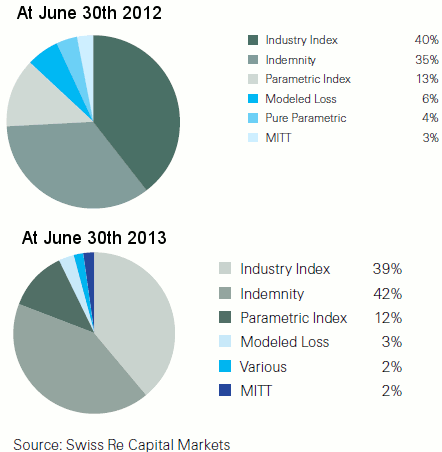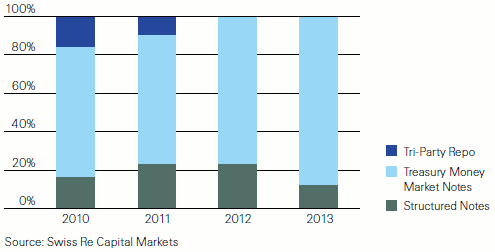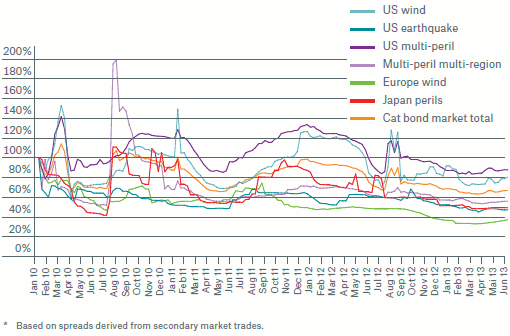With a number of reports on the insurance-linked securities (ILS) and catastrophe bond market at the end Q2 2013 having been published in recent days, we wanted to look at some of the statistics contained within. The ILS market has experienced strong issuance and achieved outright growth so the make-up of the market has shifted slightly with these deals.
To begin we’ll look at some of the data that reinsurer Swiss Re provided in its recent report, which we covered in an article a few days ago here.
The mix of triggers in the catastrophe bond market
First we’ll see if anything has changed in terms of the mix of triggers used in outstanding catastrophe bond or ILS transactions. We’ve included the same chart from Swiss Re’s ILS market report for the first-half of 2012 as well so that you can see how the mix of triggers in the outstanding catastrophe bond market has changed in the last year.

Outstanding catastrophe bonds by trigger
As you can see from the two pie-charts above, indemnity triggers have now become the most common within the outstanding cat bond market. This is the first time the market has been more weighted towards indemnity risk, over indexed risk, in its history. Interestingly, industry loss index triggers have only slipped by 1%, while the size of the market has actually grown by a number of billion dollars in that time, which suggests that use of index triggers has also increased in terms of risk-capital outstanding.
Other trigger statistics of note are that modelled loss triggers continue to lose favour and that parametric triggers continue to play an important role in the catastrophe bond market, still accounting for 12% of trigger usage, particularly on diversifying perils.
Collateral solutions used in the catastrophe bond market
Next from Swiss Re’s report we’ll look at the collateral solutions used in recent years within the ILS market. As you can see from the chart below, Treasury Money Market Notes remains the preferred collateral solution for ILS and catastrophe bond deals. It will be interesting to see how potential rises in interest rates may change this going forwards, or whether they will remain in favour.

Catastrophe bond collateral solutions
Outstanding catastrophe bonds by peril
Finally from Swiss Re’s report, here is its breakdown of the outstanding catastrophe bond market by peril. They way Swiss Re has presented this chart gives a really clear view of how dominated by U.S. wind risk the cat bond market is.
It’s interesting to note that U.S. Northeast Wind actually makes up slightly more of the market than Florida Wind, which historically was the dominant peril. Perhaps the recent trend where no serious hurricanes have hit Florida for a number of years, while the U.S. northeast has seen two major storms in recent years, has tipped the market towards a focus on transferring hurricane risk from northeastern states. It looks to us like one peril is missing from this chart, Turkish earthquake risk due to this years Bosphorus cat bond deal.

Outstanding catastrophe bonds by peril
It’s also worth us looking at a similar chart, displaying catastrophe bond risk-capital outstanding by peril, but this time from reinsurer Munich Re. We covered Munich Re’s latest ILS market report in an article on the 23rd July here, that article contains additional insight on the market and the issuance so far in 2013.
Munich Re’s chart is a little different as it stacks the perils on top of each other per year and also combines all U.S. wind into a single bracket. The way Munich Re displays the data makes the market look a little less dominated by U.S. wind and hurricane risk, but as you can see below the market is currently the most exposed to that risk that it has been since at least 2007, likely ever.

Outstanding cat bond capacity split into perils - Source: Munich Re
It’s also interesting to note that by year the amount of U.S. earthquake risk in the market is less in 2013 than it was at the end of 2012. This is likely down to the lack of a California Earthquake Authority cat bond so far this year, but it wouldn’t surprise us to see another before year-end or at the start of 2014.
Also interesting, when viewing the mix of perils in the cat bond market over time, is the shrinking of Japanese perils as part of the market. It looks like this shrinking largely occurred in 2011, the year of the Tohoku quake, but of course it also reflects the strong issuance of U.S. perils making the percentage of Japanese risk smaller. The same is true of European windstorm risk, it’s shrunk as a percentage of the market although issuance remains roughly the same.
Catastrophe bond risk spreads over time
The second chart from Munich Re’s report which shows an interesting statistical representation of the cat bond market, is this one displaying the way risk spreads on secondary catastrophe bonds have changed over time. The chart below shows the trend in cat bond risk spreads by peril and for the whole market.

Cat bond risk spreads over time (indexed) - Source: Munich Re
You can clearly see where major catastrophe events have impacted the cat bond market, as well as the seasonality inherent in certain perils. It’s also interesting to note that fluctuation in secondary risk spreads seems to have reduced in recent years, perhaps showing the maturing investor landscape with more commitment to holding cat bond positions.
Expect more statistics and data points on the ILS and cat bond market from us over the next week or two as other reports emerge.
 View all of our Artemis Live video interviews and subscribe to our podcast.
View all of our Artemis Live video interviews and subscribe to our podcast.
All of our Artemis Live insurance-linked securities (ILS), catastrophe bonds and reinsurance video content and video interviews can be accessed online.
Our Artemis Live podcast can be subscribed to using the typical podcast services providers, including Apple, Google, Spotify and more.































